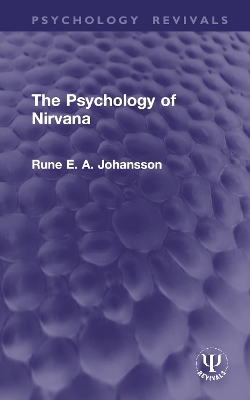
The Psychology of Nirvana
Routledge (Verlag)
978-1-032-96169-9 (ISBN)
- Noch nicht erschienen (ca. März 2025)
- Versandkostenfrei innerhalb Deutschlands
- Auch auf Rechnung
- Verfügbarkeit in der Filiale vor Ort prüfen
- Artikel merken
The oldest Pali writings are of great interest to the psychologist, not only because their analysis of mind is in many ways comparable to his own, but because their teaching has been used for practical purposes with enviable success. One of the most important of the Buddhist concepts is that of Nirvana, or nibbāna, whose modern usage has caused discomfort to many Buddhists, especially those of the Western world. Originally the name for a certain state of mind, and of personality, it has now acquired a multitude of definitions so heterogeneous and contradictory that few people know what to make of it.
Originally published in 1969, The Psychology of Nirvana was the first attempt to fit all the diffuse explanations and pronouncements of the oldest scriptures together into a consistent picture, and to relate this picture to modern Western psychology at the time. Just as Nirvana is a psychological state and the natural goal of Buddhism, mental health is the ideal of psychology. A comparative study of the two provides a book truly fascinating to scholars of psychology and Buddhism.
Rune E. A. Johansson (1918–1981) was born in Sweden. At the University of Lund he studied psychology and languages, among them Sanskrit and Pali, obtained his Licentiate Degree in 1954, and lectured there in psychology for some years. He travelled and studied extensively in the Orient, studying Sanskrit at the University of Calcutta and Pali at the University of Ceylon. During 1966–7 he was visiting Professor at the University of Tel Aviv, and at the time of original publication was head of the Biotechnical Section of the Research Institute of the Swedish National Defence.
1. Introduction 2. Method 3. The General Background 4. Some Preliminary Observations 5. Cognitive Functions in Nibbāna 6. Emotion and Feeling in Nibbāna 7. The Dynamics of Nibbāna 8. Nibbāna as State of Personality 9. Nibbāna as Emptiness 10. Nibbāna as Cessation of Rebirth 11. The Criteria of Transcendence 12. A Discussion of U 80 13. Nibbāna and Death 14. The Personality Factors and Nibbāna 15. Ways to Nibbāna 16. Nibbāna and Consciousness 17. The Personality of the Arahant 18. Summary and Conclusions. References. Index.
| Erscheint lt. Verlag | 3.3.2025 |
|---|---|
| Reihe/Serie | Psychology Revivals |
| Verlagsort | London |
| Sprache | englisch |
| Maße | 138 x 216 mm |
| Themenwelt | Geisteswissenschaften ► Psychologie ► Allgemeine Psychologie |
| Geisteswissenschaften ► Psychologie ► Verhaltenstherapie | |
| Geisteswissenschaften ► Religion / Theologie ► Buddhismus | |
| ISBN-10 | 1-032-96169-4 / 1032961694 |
| ISBN-13 | 978-1-032-96169-9 / 9781032961699 |
| Zustand | Neuware |
| Haben Sie eine Frage zum Produkt? |
aus dem Bereich


